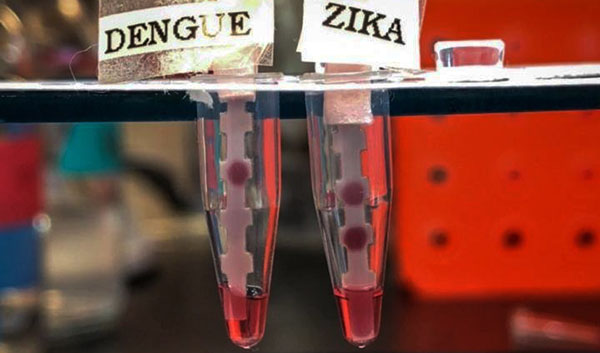Send to a friend
The details you provide on this page will not be used to send unsolicited email, and will not be sold to a 3rd party. See privacy policy.
[SÃO PAULO] A fast and cost-effective test developed by an international team of researchers could make it easier to diagnose the Zika and dengue viruses.
The test uses a strip of chromatography paper similar to that used in rapid pregnancy tests. The strip is immersed in a solution containing a small amount of blood from the infected person, and results are ready in 15 minutes.
If the paper strip becomes purple, it signals detection of a protein (antigen) called NS1. This protein is secreted by the viruses into the bloodstream in the first few days after infection.
Currently, early detection for both diseases is difficult because it relies on detecting the body’s immunological response, which begins five days after infection. It is also impossible to determine if infection has been caused by Zika or by the Dengue virus, because both microorganisms produce the NS1 protein.
The researchers overcame this challenge by developing a set of monoclonal antibodies — proteins produced from a type of immune cell — that can distinguish between an NS1 protein that has been produced by Zika and one produced by Dengue.
According to the paper, published in the journal Science Translational Medicine, the test was proved in blood samples of infected individuals from Brazil, Colombia, India and Mexico. In addition to telling apart infections caused by Zika or by Dengue, it is able to detect infection even when NSI proteins are produced in low quantity.
“The next step is to fulfil the administrative requirements of regulatory agencies in order to approve the test, and negotiate with business and government sectors to make its commercial production possible soon”, said Lee Gehrke, from the Massachusetts Institute of Technology and a co-author of the study, in an interview with SciDev.Net.
The test's current cost of production is estimated at US$5, but according to Gehrke this could be lowered as the quantities produced increase.
He says the team intends to use the same method to detect other viruses — such as Usutu, which is transmitted by Culex mosquitoes, and Powassan, transmitted by ticks — that have the potential to become a threat for human health.
For Valtencir Zucolotto, materials engineer at the Institute of Physics of the University of Sao Paulo, the new test is a positive development due its ability to clearly distinguish between the four known serotypes of Dengue and Zika.“This approach involves a quite complex work of molecular biology and might be useful for rapid and cost-effective diagnosis in endemic areas of the world where Zika and Dengue virus circulate at the same time”, added Zucolotto.
The study published in Science Translational Medicine is a result of projects funded by FAPESP, a SciDev.Net donor.
This piece was originally published on SciDev.Net’s Global edition.


